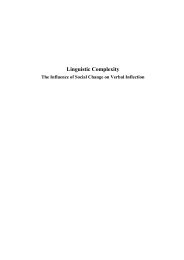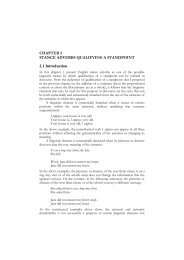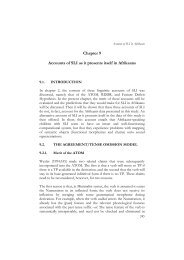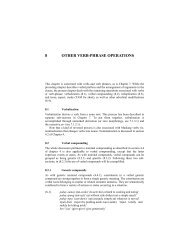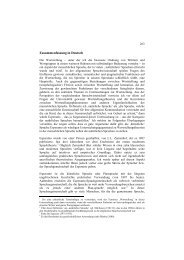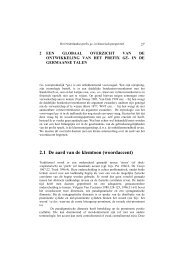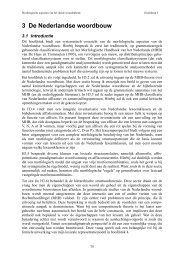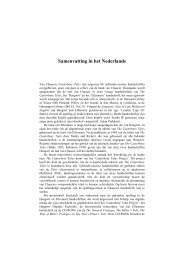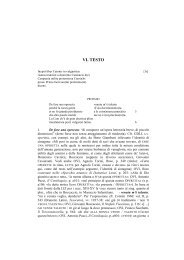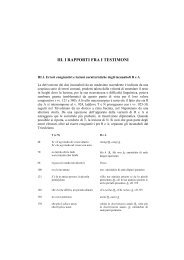Chapter 2 - LOT publications
Chapter 2 - LOT publications
Chapter 2 - LOT publications
You also want an ePaper? Increase the reach of your titles
YUMPU automatically turns print PDFs into web optimized ePapers that Google loves.
<strong>Chapter</strong> 2<br />
In Oromo, similative causatives are used when someone speaks about somebody as<br />
if she/he were bringing about the causative event in the mind. They are marked by<br />
CAUS 3 causative marking –eess- as shown in (19-20):<br />
19. inni kan- iyoo fag-eess-e-e ilaal-a<br />
he:NOM COMP-near far- CAUS 3 -3M:PF-CON see-3M:IMPF<br />
‘He is far sighted.’/ lit., ‘He sees something that is near as if it were far.’<br />
20. inni soba ɗugaa fakk-eess-e-e dubbat-a<br />
he:NOM false true appear- CAUS 3 -3M:PF-CON speak-3M:IMPF<br />
‘He speaks false to appear true.’<br />
In (19) the causer perceives something which is near as if it were far. This means<br />
that the causer makes something which is near to appear as if it were far. In (20), the<br />
causer makes something which is false as if it were true to the mind of the hearer/listener.<br />
The causer makes things appear near or far, false or true to himself or to<br />
the mind of the addressee.<br />
In general in Oromo, indirect, similative and assistive causatives are differentiated<br />
grammatically; indirect causatives are double causatives, similative causatives are<br />
formed by CAUS 3 and assistive causatives are formed by MID + CAUS 1 in at least<br />
one dialect of Oromo.<br />
2.5. Amount of Agents or of Causers<br />
2.5.1. Does the Number of Agents Match with the Number<br />
of –s ’s?<br />
In this section, I argue that the number of causative morpheme –s-’s does not always<br />
match the number of agents. In the earlier analysis, Lloret (1987) and Dubinsky,<br />
Lloret and Newman (1988) correlate the number of -s-’s with the number of<br />
agents. Lloret (1987:143) supports Hayward’s observation that non-agentive intransitives<br />
add the morpheme –s- while agentive intransitives add the causative morpheme<br />
–sis- to argue that the number of –s-’s in the causative verb matches with the<br />
number of agentive arguments. The same concept is further developed by Dubinsky<br />
et al. (1988). Dubinsky et al. (1988) correlate the number of –s-’s with the number<br />
of subjects within the framework of grammatical relations.<br />
But close investigation shows that such an analysis runs into problems. I point out<br />
some of these problems. First, causatives of non-agentive intransitive verbs such as<br />
diriir-s- ‘spread’, dab-s- ‘bend (tr.)’, gog-s- ‘dry (tr.)’, etc. optionally geminate<br />
their causative morphemes to increase the number of –s-’s to two with no change of<br />
meaning as in diriir-ss- ‘spread’, dab-ss- ‘bend (tr.)’, gog-ss- ‘dry (tr.)’. Obviously,<br />
in this case the number of –s-’s does not match with the number of subjects<br />
22



